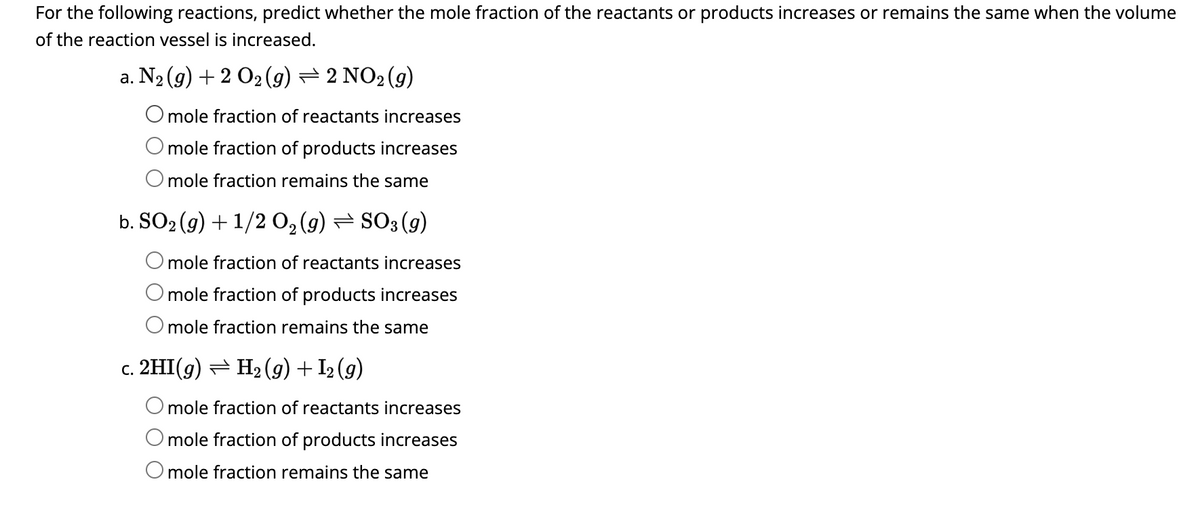For the following reactions, predict whether the mole fraction of the reactants or products increases or remains the same when the volume of the reaction vessel is increased. a. N₂(g) + 2 O₂ (g) ⇒ 2 NO₂ (g) O mole fraction of reactants increases O mole fraction of products increases O mole fraction remains the same b. SO₂ (g) + 1/2 O₂(g) ⇒ SO3 (9) O mole fraction of reactants increases O mole fraction of products increases O mole fraction remains the same c. 2HI(g) ⇒ H₂(g) + 1₂ (9) O mole fraction of reactants increases O mole fraction of products increases O mole fraction remains the same
For the following reactions, predict whether the mole fraction of the reactants or products increases or remains the same when the volume of the reaction vessel is increased. a. N₂(g) + 2 O₂ (g) ⇒ 2 NO₂ (g) O mole fraction of reactants increases O mole fraction of products increases O mole fraction remains the same b. SO₂ (g) + 1/2 O₂(g) ⇒ SO3 (9) O mole fraction of reactants increases O mole fraction of products increases O mole fraction remains the same c. 2HI(g) ⇒ H₂(g) + 1₂ (9) O mole fraction of reactants increases O mole fraction of products increases O mole fraction remains the same
Chemistry for Engineering Students
4th Edition
ISBN:9781337398909
Author:Lawrence S. Brown, Tom Holme
Publisher:Lawrence S. Brown, Tom Holme
Chapter12: Chemical Equilibrium
Section: Chapter Questions
Problem 12.34PAE: 1’he reaction in Exercise 12.33 was repeated. This time, the reaction began when only NO was...
Related questions
Question

Transcribed Image Text:For the following reactions, predict whether the mole fraction of the reactants or products increases or remains the same when the volume
of the reaction vessel is increased.
a. N₂ (g) + 2 O₂ (g) — 2 NO₂ (g)
O mole fraction of reactants increases
mole fraction of products increases
O mole fraction remains the same
b. SO₂(g) + 1/2 0₂ (9) ⇒ SO3 (9)
O mole fraction of reactants increases
O mole fraction of products increases
O mole fraction remains the same
c. 2HI(g) ⇒ H₂ (9) + 12 (9)
mole fraction of reactants increases
mole fraction of products increases
O mole fraction remains the same
![An initial mixture of nitrogen gas and hydrogen gas is reacted in a rigid container at a certain temperature by the reaction
3 H2(g) + N2(g) → 2 NH3(g)
At equilibrium, the concentrations are [H₂] = 6.0 M, [N₂] = 12 M, and [NH3] = 4.0 M. What were the concentrations of nitrogen gas and
hydrogen gas that were reacted initially?
[H2]0= 0.5 M
[N2]0= = 6.5
M](/v2/_next/image?url=https%3A%2F%2Fcontent.bartleby.com%2Fqna-images%2Fquestion%2F16140577-95fc-4112-8b0a-8e4365545066%2F0362faca-895e-470b-85dc-70ec5cac7b58%2Fnmuft5o_processed.png&w=3840&q=75)
Transcribed Image Text:An initial mixture of nitrogen gas and hydrogen gas is reacted in a rigid container at a certain temperature by the reaction
3 H2(g) + N2(g) → 2 NH3(g)
At equilibrium, the concentrations are [H₂] = 6.0 M, [N₂] = 12 M, and [NH3] = 4.0 M. What were the concentrations of nitrogen gas and
hydrogen gas that were reacted initially?
[H2]0= 0.5 M
[N2]0= = 6.5
M
Expert Solution
This question has been solved!
Explore an expertly crafted, step-by-step solution for a thorough understanding of key concepts.
Step by step
Solved in 3 steps with 2 images

Knowledge Booster
Learn more about
Need a deep-dive on the concept behind this application? Look no further. Learn more about this topic, chemistry and related others by exploring similar questions and additional content below.Recommended textbooks for you

Chemistry for Engineering Students
Chemistry
ISBN:
9781337398909
Author:
Lawrence S. Brown, Tom Holme
Publisher:
Cengage Learning

Chemistry: The Molecular Science
Chemistry
ISBN:
9781285199047
Author:
John W. Moore, Conrad L. Stanitski
Publisher:
Cengage Learning

Chemistry: Principles and Practice
Chemistry
ISBN:
9780534420123
Author:
Daniel L. Reger, Scott R. Goode, David W. Ball, Edward Mercer
Publisher:
Cengage Learning

Chemistry for Engineering Students
Chemistry
ISBN:
9781337398909
Author:
Lawrence S. Brown, Tom Holme
Publisher:
Cengage Learning

Chemistry: The Molecular Science
Chemistry
ISBN:
9781285199047
Author:
John W. Moore, Conrad L. Stanitski
Publisher:
Cengage Learning

Chemistry: Principles and Practice
Chemistry
ISBN:
9780534420123
Author:
Daniel L. Reger, Scott R. Goode, David W. Ball, Edward Mercer
Publisher:
Cengage Learning

Chemistry & Chemical Reactivity
Chemistry
ISBN:
9781133949640
Author:
John C. Kotz, Paul M. Treichel, John Townsend, David Treichel
Publisher:
Cengage Learning

Chemistry & Chemical Reactivity
Chemistry
ISBN:
9781337399074
Author:
John C. Kotz, Paul M. Treichel, John Townsend, David Treichel
Publisher:
Cengage Learning

Chemistry: Matter and Change
Chemistry
ISBN:
9780078746376
Author:
Dinah Zike, Laurel Dingrando, Nicholas Hainen, Cheryl Wistrom
Publisher:
Glencoe/McGraw-Hill School Pub Co